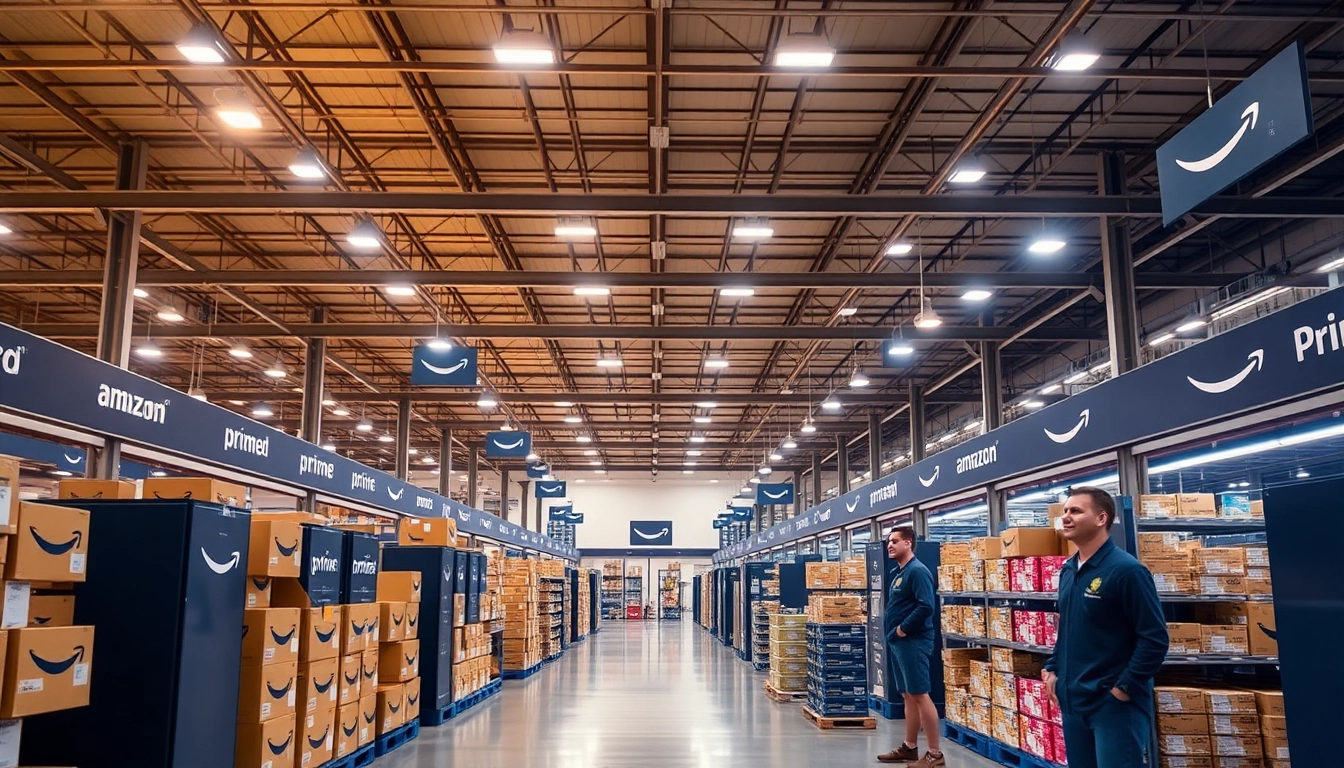Understanding Amazon Seller Fulfilled Prime
What Is Amazon Seller Fulfilled Prime?
Amazon Seller Fulfilled Prime (SFP) is a fulfillment program that allows third-party sellers to offer the Prime badge on their products while handling their own shipping. This initiative enables sellers to deliver products directly from their own warehouse or fulfillment center to Prime customers, thereby tapping into the extensive Prime customer base. By participating in this program, sellers can provide one-day and two-day delivery options, aligning their offerings with the expectations of Amazon Prime members. This approach not only enhances product visibility but also creates a competitive edge in the bustling e-commerce marketplace. If you’re looking to leverage Amazon seller fulfilled prime to optimize your business, understanding the core aspects of the program is essential.
Key Features of Seller Fulfilled Prime
- Prime Badge: Sellers can display the Prime badge on their listings, signifying trust and expedited shipping.
- Control Over Inventory: Unlike Fulfillment by Amazon (FBA), sellers maintain control over their inventory and shipping processes.
- Fast Shipping Options: Eligible sellers can offer one and two-day shipping options, meeting Prime delivery standards.
- Global Reach: Sellers can reach millions of Prime customers worldwide, enhancing visibility and potential sales volume.
- Flexibility: Sellers can customize their fulfillment processes to meet their unique operational needs.
Eligibility and Enrollment Process
To participate in Seller Fulfilled Prime, sellers must meet specific eligibility criteria, including maintaining high performance metrics. The first step towards enrollment is to pre-qualify for a Seller Fulfilled Prime trial. This involves fulfilling at least 100 orders in the past 90 days with an acceptable cancellation rate (less than 2.5%) and a valid tracking rate (exceeding 95%). Once pre-qualified, sellers must pass an additional evaluation trial to demonstrate their readiness to meet Prime shipping standards consistently.
The enrollment process also includes an audit of the logistics framework, ensuring sellers can meet the stringent delivery timelines and service requirements expected by Amazon. Upon successful enrollment, sellers can start putting the Prime badge on their listings, significantly boosting their product visibility.
Comparing Seller Fulfilled Prime with Fulfillment by Amazon
Differences Between SFP and FBA
The most significant difference between Seller Fulfilled Prime (SFP) and Fulfillment by Amazon (FBA) lies in the ownership of the fulfillment process. With FBA, Amazon takes care of storage, packing, and shipping of products, allowing sellers to focus on other aspects of their business. Conversely, SFP allows sellers to manage their fulfillment operations while still benefiting from the Prime badge.
Moreover, the cost structure varies: FBA charges sellers based on storage space and fulfillment fees, while SFP costs can be more variable, depending on the seller’s logistics framework, shipping rates, and ability to maintain Prime delivery standards. Sellers using SFP also need to deal with customer service and returns, responsibilities typically handled by Amazon under the FBA model.
Pros and Cons of Both Fulfillment Methods
Advantages of Seller Fulfilled Prime
Sellers using Seller Fulfilled Prime can benefit from:
- Increased Control: Sellers dictate their fulfillment process and manage customer service personally.
- Cost Efficiency: For some sellers, managing fulfillment in-house can lead to cost savings, especially if they already have efficient logistics systems in place.
- Customized Customer Experience: Sellers can tailor their shipping and return policies to better align with their brand identity.
Disadvantages of Seller Fulfilled Prime
On the flip side, managing fulfillment can be demanding, and encompasses risks such as:
- High Standards: Sellers must consistently meet strict performance metrics set by Amazon to maintain their Prime eligibility.
- Complex Operations: Handling logistics internally can introduce challenges in scaling and managing costs effectively during peak seasons.
Advantages of Fulfillment by Amazon
Fulfillment by Amazon has its own set of benefits, such as:
- Ease of Management: FBA automates most logistics processes, allowing sellers to shift focus to marketing and sales.
- Amazon’s Customer Service: Sellers benefit from Amazon’s established customer service and returns handling.
Disadvantages of Fulfillment by Amazon
However, FBA isn’t without its downsides:
- Fees: The costs associated with FBA can erode profit margins, particularly for low-priced items.
- Less Control: Sellers forfeit control over the packaging and shipping process, which can impact brand perception.
Choosing the Right Fit for Your Business
Deciding between Seller Fulfilled Prime and Fulfillment by Amazon depends on multiple factors, including the seller’s operational capabilities, cost structure, and customer service preferences. Evaluate the logistics infrastructure in place and consider whether it can handle the rigorous demands of Prime delivery. For sellers who prioritize brand image and customer experience and have the capacity to manage logistics effectively, SFP may offer a perfect solution. Conversely, those seeking ease of operation may find FBA a more suitable option.
Benefits of Amazon Seller Fulfilled Prime
Increased Visibility and Sales
Obtaining the Prime badge through Seller Fulfilled Prime significantly boosts product visibility on Amazon’s platform. Prime members are more likely to make purchases from sellers offering Prime shipping options, leading to increased sales potential. The psychological impact of the Prime badge acts as a trust signal for customers, which can elevate conversion rates by differentiating products in a crowded marketplace.
Access to Prime Customer Base
By enrolling in SFP, sellers gain access to Amazon’s vast audience of Prime members, a segment that actively looks for products eligible for expedited shipping. This access can lead to enhanced market reach and more consistent sales. Moreover, products that fulfill Prime requirements experience higher listing priority in search results, resulting in additional visibility and sales opportunities.
Enhanced Customer Trust with Prime Branding
Consumers trust the Amazon brand, and by associating their products with the Prime badge, sellers not only leverage Amazon’s reputation but also enhance their credibility. Trust is a primary driver of sales, and providing customers with the confidence that they will receive fast and reliable delivery can lead to repeat business and positive reviews. This trust translates into long-term customer relationships and brand loyalty.
Challenges in Managing Seller Fulfilled Prime
Meeting Prime Delivery Standards
One of the most daunting challenges for sellers is meeting Amazon’s high standards for delivery. Sellers must fulfill orders within strict time frames (typically within one or two days), which requires robust logistics and operational efficiency. Failure to meet these standards not only jeopardizes Prime status but can also negatively impact seller metrics, resulting in penalties or removal from the program.
Maintaining High Performance Metrics
To remain eligible for the Prime badge, sellers must consistently uphold strong performance indicators, including low cancellation and return rates alongside high valid tracking rates. This demands diligent attention to inventory management, shipping processes, and customer service operations. Sellers must implement rigorous monitoring and improvement strategies to protect their standing within the program.
Handling Returns and Customer Service
With Seller Fulfilled Prime, sellers take on the responsibility of customer service and returns, which can be challenging. Efficiently handling returns and ensuring customer satisfaction are vital to maintaining good seller metrics. Developing a reliable system for processing returns and managing customer inquiries can mitigate these challenges and enhance overall customer experience.
Best Practices for Success with Seller Fulfilled Prime
Tips for Efficient Order Fulfillment
Building an efficient order fulfillment process is crucial for SFP success. Here are some strategies to consider:
- Streamline Operations: Optimize every stage of the order process, from inventory management to shipping. Utilize fulfillment software to enhance tracking and streamline communication.
- Leverage Local Shipping Partners: Collaborating with reliable shipping partners can improve delivery times and reduce costs, ensuring you meet Amazon’s expectations.
Utilizing Technology for Order Management
Investing in technology can significantly enhance operational efficiency for SFP participation. Utilize order management systems and automated fulfillment solutions to track inventory levels, manage orders, and analyze shipping data. An advanced system can ensure your operations are agile and responsive to fluctuations in demand, while also keeping shipping costs in check.
Strategies for Customer Engagement and Retention
Building a loyal customer base requires proactive engagement. Following these practices can enhance customer relationships:
- Exceptional Customer Service: Prioritize responsiveness to inquiries and complaints, creating a seamless and positive experience for customers.
- Feedback and Reviews: Encourage customers to leave reviews and ratings. Use their feedback to continuously improve your fulfillment processes.
- Loyalty Programs: Consider implementing loyalty programs that reward repeat customers with discounts or exclusive offers, fostering long-term relationships.



